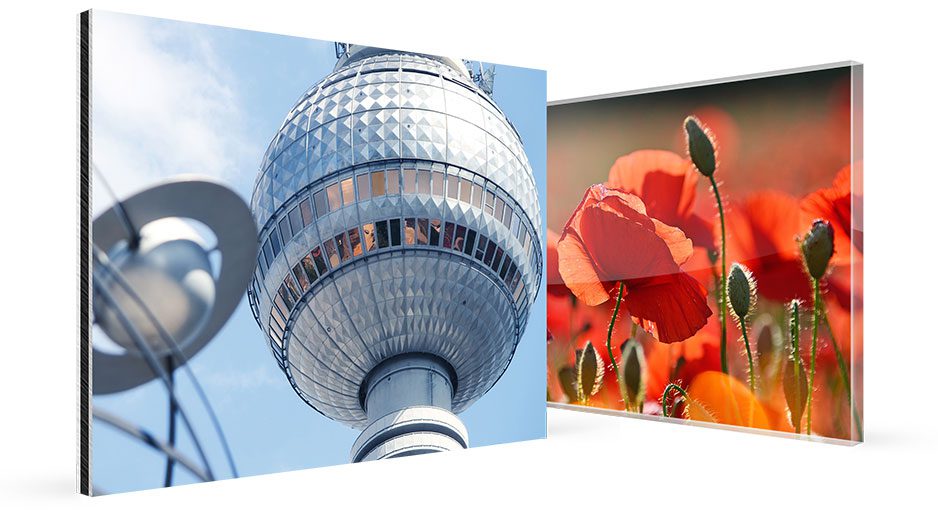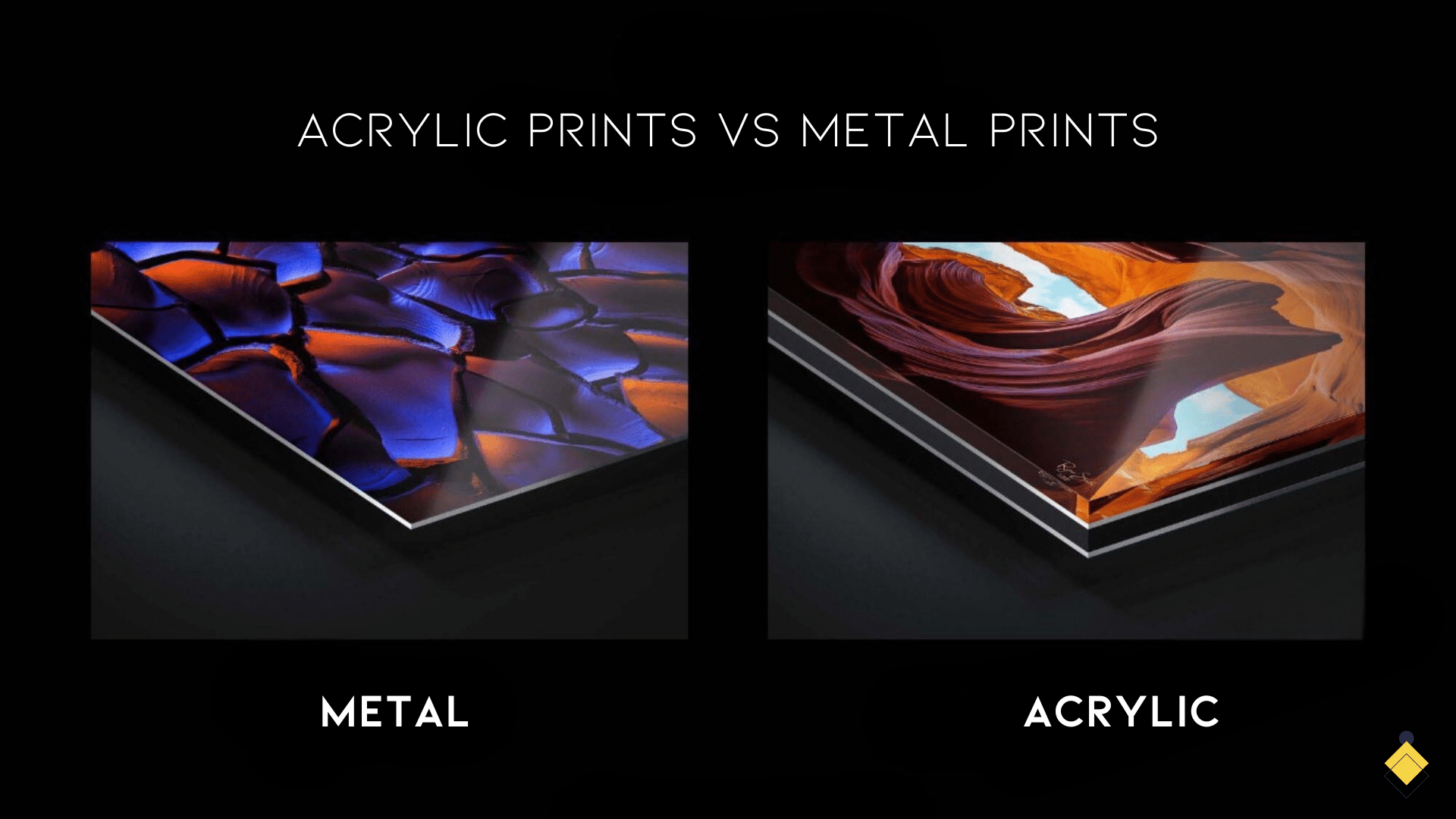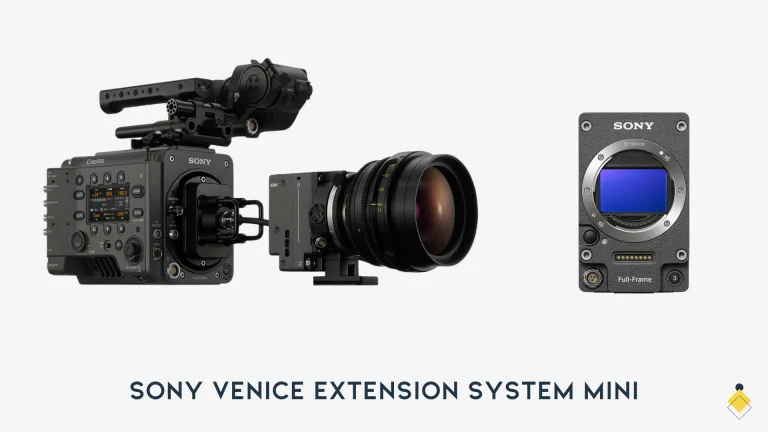When it comes to decorating your home or office with beautiful photographic prints, two of the most popular options are acrylic and metal prints. But what exactly are acrylic and metal prints, and how do they compare in terms of quality, durability, and overall value? This comprehensive guide examines the key differences between acrylic vs metal prints to help you determine which type of print is the best option for displaying your favorite photos.
Acrylic and metal prints are both modern wall art techniques that can make your images really stand out. They each have their own unique characteristics and advantages compared to traditional paper prints.
In determining whether acrylic or metal is better for your needs, here are some of the main factors to consider:
- Print quality
- Durability
- Glare/reflection
- Cost
- Appearance and aesthetics
Looking at these key criteria in-depth will provide the information you need to decide if acrylic or metal is the right print choice for your photos.
What Are Acrylic Prints?

Acrylic prints, sometimes called plexiglass prints, are made by printing a photo directly onto high-quality acrylic sheets. The acrylic provides a crystal clear face that allows the colors and details of the image to really pop.
To create an acrylic print, the image is printed directly onto the underside of a clear acrylic sheet using specialized wide-format printers. The acrylic surface is then mounted onto a sturdy backing, such as wood, metal, or other acrylic sheets, to provide structure and rigidity.
The finished piece is an acrylic photo print that can be proudly displayed on the wall like a work of art. Acrylic is an excellent material choice for photographic prints because of its optical clarity, lightweight composition, and modern aesthetic.
What Are Metal Prints?
Metal prints have become an increasingly popular wall art option over the last decade. Like acrylic prints, they provide a sleek, contemporary look for showcasing photographs.
Metal prints are made by printing your image directly onto a sheet of aluminum or other metal using a dye-sublimation process. The metal provides a slick, durable surface for the photographic print.
The base metal is coated with a special polymer powder coating that accepts the printed ink. Under intense heat and pressure, the ink infuses into the powder coating to adhere permanently to the metal surface.
Once cooled, the strong, lightweight metal print is ready to hang on the wall with its vivid colors and details on full display. Metal’s smooth, brilliant surface makes photos pop while adding metallic allure.

Print Quality: How Acrylic and Metal Prints Compare
When evaluating acrylic vs metal prints, one of the most important considerations is the overall print quality. Which material produces better looking photographic prints?
Both acrylic and metal offer excellent print quality, but there are some differences in how the materials render images.
Acrylic has an extremely clear face that allows colors to appear rich and true without distortion. Since the print sits under the surface, you get a smooth, seamless look without seeing the texture of the ink. Photos printed on acrylic have vivid hues and crisp details.
Metal prints also produce brilliant photographic reproductions thanks to the semi-gloss, light-reflective surface. The dye-sublimation process infuses the ink into the coated metal for excellent color accuracy. With metal, you may notice slight texturing from the ink dots on close inspection.
Many professional photographers consider acrylic to have the edge in ultimate print clarity and depth. But metal also does an amazing job representing colors and details accurately. Either material will provide stunning photographic reproduction quality.
Durability
Durability is a major determinant in choosing acrylic vs metal prints. You want your wall art to maintain its visual splendor for years to come.
When it comes to toughness and longevity, metal prints have the advantage. The durable aluminum surface is waterproof and dent-resistant. Metal prints can withstand being bumped without damage. They are also scratch-resistant when handled properly.
Acrylic prints are reasonably tough but more prone to scratches than metal. The acrylic face can be scratched if not cared for properly. Acrylic also can crack if subjected to a sharp direct impact.
However, acrylic prints are still remarkably durable for everyday use when handled with care. High-quality acrylic is strong and shatter-resistant. The mounting helps keep the acrylic structurally sound. Overall, modern acrylic prints will provide many years of enjoyment before signs of wear.
For applications where prints may be subjected to heavy use and abuse, metal is the safest bet for long-lasting durability. But don’t count acrylic out – its optical clarity gives it good staying power.

Glare Reduction
How the print material displays in different lighting conditions is another key comparison point. Glare and reflections can detract from a print’s appearance.
Acrylic prints have the advantage when it comes to glare reduction. The acrylic face virtually eliminates glare from indoor lighting. Colors stay rich and vivid at various angles. This makes acrylic an exceptionally ideal print choice for professional settings with bright overheard lights, such as offices, restaurants, and galleries.
The semi-glossy metal surface is more prone to reflect overhead lights and windows, especially from sharp angles. There are specialized coatings that can minimize glare on metal prints. But some visible reflections will usually still occur with strong directional lighting.
If reducing glare is a priority for how and where you’ll display the print, acrylic is likely the best option. Acrylic’s optical clarity neatly eliminates reflections for dazzling image clarity.
Cost Comparison
How do the costs of acrylic vs metal prints compare? Not surprisingly, printing directly on metal generally costs more than acrylic.
Metal is inherently a more expensive base material than acrylic. The processing costs are also higher for printing on metal, requiring sophisticated dye-sublimation equipment and techniques. These factors mean metal prints often cost at least twice as much as comparable acrylic prints.
However, acrylic is not necessarily cheap. It is still considered a specialty print material. Professionally printed acrylic photos are higher quality than basic paper prints. But acrylic provides an attractive look for less than metal.
Print sizes, image quality, and other custom options also affect the final price. For top-tier professional photos, some photographers may prefer metal regardless of cost. For larger prints or multiple copies, acrylic is likely the more budget-friendly choice.
Appearance: Both Look Great But Have Different Styles
Both acrylic and metal prints offer stunning photographic reproduction and modern elegance. However, there are subtle aesthetic differences between the two materials.
Acrylic has a clearer, brighter, more pristine appearance. Colors seem to glow thanks to the see-through acrylic face and lack of surface glare. The transparent finish showcases fine details beautifully. Photos printed on acrylic have an artistic, gallery-like look.
Metal prints have a cooler, sleeker, more tech-like vibe. The metallic sheen gives images a vibrant polish. The semi-gloss surface provides visual depth without revealing every facet. Metal prints have an edgy, almost industrial feel.
The choice between acrylic vs metal may simply come down to which material fits your preferred decorating style. Acrylic brings out photos’ fine art side. Metal emphasizes their modern graphic allure. Both materials make images leap off the wall in their own aesthetically pleasing ways.

Which Is Better for Photography: Metal or Acrylic?
For photographers looking to sell high-end prints, both acrylic and metal make excellent print mediums. Many photographers offer their clients a choice between the two materials.
Here are some tips on when metal or acrylic may be the best option for displaying photographic prints:
- For professional portraiture, like senior photos or family portraits, acrylic often provides the ultimate print quality to capture every perfect detail. The transparent finish complements portraiture’s softer, warmer side.
- For commercial product photography, metal prints’ sleek, polished finish enhances products’ sleek industrial lines and tech appeal. Metal brings out products’ modern sophistication.
- For nature and landscape photography, acrylic’s crystal clarity showcases the intricate nuances of natural scenery. The deep perspective adds depth to wide scenic vistas.
- For cityscapes, metal prints complement architectural photography, emphasizing the sharp lines and geometric patterns found in urban environments.
- Black & white photography also looks stunning on metal prints. The metallic sheen works perfectly with black & white’s graphic artistry.
The takeaway is that both metal and acrylic offer awesome ways to display photography professionally. It depends on the subject matter and desired mood which material is a better fit. For galleries or collections, mixing acrylic and metal prints provides visual variety. Both materials give photographic prints artistic gravitas and presence.
Should I Choose Acrylic or Metal Prints?
In conclusion, both acrylic and metal produce stunning photographic prints, but they have visual and practical differences.
Here are some final tips on choosing acrylic vs metal prints:
- Acrylic is the winner for ultimate optical clarity and color accuracy. Go with acrylic if you want the purest photographic reproduction.
- Metal stands out for its rugged durability and unique metallic allure. Choose metal if you want prints virtually impervious to damage.
- Acrylic prints cost less than metal in most cases. Acrylic is the more budget-friendly option for large or multiple prints.
- Acrylic better resists glare if lighting conditions are a concern. Metal gives a cooler, tech-inspired look.
- Consider the photo subject matter and decor. Acrylic excels for fine art photography. Metal complements graphic, modern styles.
- Either acrylic or metal is perfect for professional photographic prints. Choose based on the specific image.
- Mixing metallic and acrylic prints provides visual intrigue. Both offer gallery-quality art prints.
Weigh the differences in appearance, cost, durability, and print quality carefully. For many, the ideal solution is having some photos printed on acrylic and others on metal. This allows you to match the print medium to the image. With quality acrylic and metal prints showcasing your photography professionally, you can’t go wrong!
FAQ – Acrylic Prints vs Metal Prints

Acrylic prints are made by printing an image onto photo paper and then sealing it behind a thick acrylic sheet, while metal prints are made by infusing dyes directly into a specially coated aluminum sheet.
Both acrylic and metal prints are excellent choices for fine art photography due to their high-quality finish and durability, but the choice ultimately depends on personal preference and the specific characteristics of the image.
Both acrylic and metal prints offer vibrant colors, a modern and sleek look, and are known for their durability and longevity.
Metal prints are known for their exceptional longevity, especially when protected from direct sunlight, while acrylic prints also offer a long lifespan but may be more prone to damage in direct sunlight.
Both acrylic and metal prints offer exceptional print quality, but the choice between the two ultimately depends on the specific characteristics of the image and the desired finish.
Metal prints have a glossy finish and provide a modern and sleek look, while acrylic prints offer a more traditional and luxurious appearance with a high-gloss finish.
Metal prints are an excellent choice for art galleries due to their durability and modern appearance, while acrylic prints also make an elegant and sophisticated option, but may require additional care to prevent damage from direct sunlight.
Acrylic prints tend to be thicker and have a more substantial feel compared to metal prints, making them an attractive option for those seeking a more substantial piece of wall art.
Metal prints are created by infusing dyes into specially coated aluminum sheets using a heat press, while acrylic prints involve printing the image onto photo paper and then sealing it behind a thick acrylic sheet using a chemical bonding process.
While both metal and acrylic prints offer some level of UV protection, metal prints are generally more resistant to damage from direct sunlight, making them the preferred choice for spaces with significant sun exposure.





